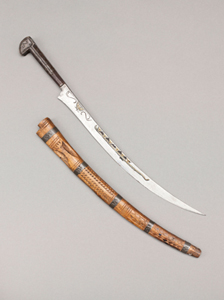All along the exhibition
historians share their analysis |
 |
Napoleon III’s Arab Kingdom
M. Levallois
|
In the wake of Abdelkader’s surrender, the short-lived Second Republic outlined a policy of assimilation and settlement. The 1848 Constitution stated that Algeria was a “French territory” and divided it into three départements. Yet the conquest wasn’t over and uprisings were severely crushed. From 1852, the Second Empire strengthened the role of the military in administering the territories and gave a new boost to the conquest. Once appointed governor of Algeria, General Randon first brought under submission the oases of the Algerian Northern Sahara and in 1857 Kabylia, the last independent stronghold at the heart of Algeria.
|
|
|
 Poignard kabyle (flissah) Poignard kabyle (flissah)© Paris - Musée de l'Armée, Dist. RMN-GP/Emilie Cambier |

